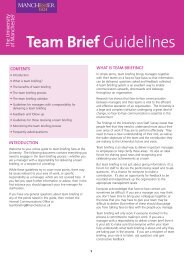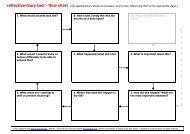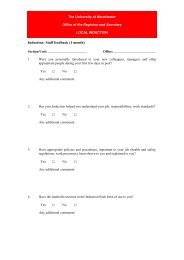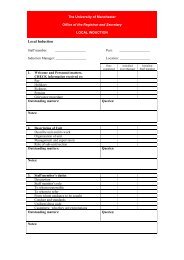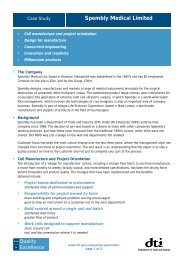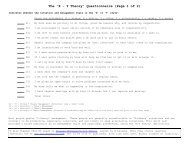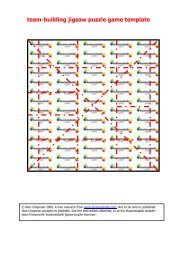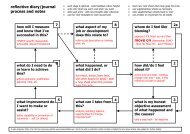SIX SIGMA FACTSHEET Six Sigma aims to ... - Businessballs
SIX SIGMA FACTSHEET Six Sigma aims to ... - Businessballs
SIX SIGMA FACTSHEET Six Sigma aims to ... - Businessballs
- No tags were found...
Create successful ePaper yourself
Turn your PDF publications into a flip-book with our unique Google optimized e-Paper software.
<strong>SIX</strong> <strong>SIGMA</strong><strong>FACTSHEET</strong>● Develop operational definitions● Measure the symp<strong>to</strong>m● Define the boundaries – that is, the scope of the improvementproject● Concentrate on the vital few – those sources of error thought<strong>to</strong> be largely responsible for the problem. It is timeconsuming <strong>to</strong> attempt <strong>to</strong> tackle all possible sources, and theresult may not justify the effort.Once the above analysis of the symp<strong>to</strong>ms has been completed,the mission statement should be revisited <strong>to</strong> confirm that it isstill applicable, or <strong>to</strong> modify it <strong>to</strong> make it applicable. The resultsof the analysis may reveal that the problem is somewhatdifferent from the one that was originally described; or that theimprovement project is <strong>to</strong>o large and needs <strong>to</strong> be broken downin<strong>to</strong> more manageable parts.Step 3 – AnalyseDuring this Analyse step, theories about the causes of theproblem are formulated, these theories are tested, and, finallythe root causes of the problem are identified.● FORMULATING THE THEORIES – the project teambrains<strong>to</strong>rms possible theories, documents them, and thenorganises them in the form of a cause-and-effect diagram.● TESTING THE THEORIES – before any theory can be accepted astrue, it must be systematically tested. Any data required <strong>to</strong> testa particular theory, that is not available, must first be collected.If the data collected demonstrates that a particular theory isclearly not important, then that theory can be eliminated.● IDENTIFYING THE ROOT CAUSE(S) – once testing has beencompleted, the root cause(s) of the problem should be able <strong>to</strong>be determined.Once found, the removal of the real root cause(s) will sharplyreduce or eliminate the problem/deficiency.Step 4 – ImproveDuring this Improve step, several sequential activities areperformed and these are described below.● EVALUATION OF ALTERNATIVES – alternative improvementmethods are evaluated <strong>to</strong> determine which method will bestremove, or reduce the effect of, the root cause(s) of the4
<strong>SIX</strong> <strong>SIGMA</strong><strong>FACTSHEET</strong>problem. This evaluation is carried out using a set ofevaluation criteria such as cost, impact, cost/benefit ratio,cultural impact etc● DESIGN OF THE IMPROVEMENT – an improvement methodhas been selected, the improvement process is designed byconfirm that the improvement achieves the project goals;determining the required resources; specify the proceduresand the other changes required; assessing human resourcerequirements <strong>to</strong> determine whether any training/re-training isrequired.● PLAN FOR “CULTURAL RESISTANCE” – by their very nature,improvement efforts create change in an organisation and“cultural resistance” is a natural consequence of change.Therefore, dealing with this potential cultural resistance needs<strong>to</strong> be fac<strong>to</strong>red in<strong>to</strong> the improvement project plan.● PROVE EFFECTIVENESS – before an improvement is finallyadopted, it must be proven effective under operatingconditions. This could be done with a pilot test; a dry run,which doesn’t involve delivery <strong>to</strong> the cus<strong>to</strong>mer; an acceptancetest; a simulation● IMPLEMENT – this involves introducing the proposed change<strong>to</strong> the people that will make it work. This demands: a clearplan; a description of the change; an explanation indicatingwhy the change is necessary; involvement of those affected;the change.The most important parts of implementation, though, are goodplanning, good preparation, and good cooperation between allof the individuals concerned.Step 5 – ControlDuring this Control step, controls are put in place <strong>to</strong> ensure thatthe gains that have been achieved will continue and theproblem will not recur. To do this the following activities need <strong>to</strong>be carried out.● Design effective quality controls● Foolproof the improvement● Audit the controls.For more information on Achieving best practice in your business:● Visit our website at www.dti.gov.uk/bestpractice● Call us on 0870 150 2500 <strong>to</strong> order from our range of freebest practice publications or visit www.dti.gov.uk/publications● Contact your local Business Link adviser by visiting the website atwww.businesslink.gov.uk or calling 0845 600 9 006Published by the Department of Trade and Industry. www.dti.gov.uk© Crown Copyright. 04/045



